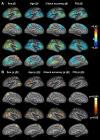Heritability of working memory brain activation
- PMID: 21795540
- PMCID: PMC3163233
- DOI: 10.1523/JNEUROSCI.5334-10.2011
Heritability of working memory brain activation
Abstract
Although key to understanding individual variation in task-related brain activation, the genetic contribution to these individual differences remains largely unknown. Here we report voxel-by-voxel genetic model fitting in a large sample of 319 healthy, young adult, human identical and fraternal twins (mean ± SD age, 23.6 ± 1.8 years) who performed an n-back working memory task during functional magnetic resonance imaging (fMRI) at a high magnetic field (4 tesla). Patterns of task-related brain response (BOLD signal difference of 2-back minus 0-back) were significantly heritable, with the highest estimates (40-65%) in the inferior, middle, and superior frontal gyri, left supplementary motor area, precentral and postcentral gyri, middle cingulate cortex, superior medial gyrus, angular gyrus, superior parietal lobule, including precuneus, and superior occipital gyri. Furthermore, high test-retest reliability for a subsample of 40 twins indicates that nongenetic variance in the fMRI brain response is largely due to unique environmental influences rather than measurement error. Individual variations in activation of the working memory network are therefore significantly influenced by genetic factors. By establishing the heritability of cognitive brain function in a large sample that affords good statistical power, and using voxel-by-voxel analyses, this study provides the necessary evidence for task-related brain activation to be considered as an endophenotype for psychiatric or neurological disorders, and represents a substantial new contribution to the field of neuroimaging genetics. These genetic brain maps should facilitate discovery of gene variants influencing cognitive brain function through genome-wide association studies, potentially opening up new avenues in the treatment of brain disorders.
Figures




References
-
- Ando J, Ono Y, Wright MJ. Genetic structure of spatial and verbal working memory. Behav Genet. 2001;31:615–624. - PubMed
-
- Bell EC, Willson MC, Wilman AH, Dave S, Silverstone PH. Males and females differ in brain activation during cognitive tasks. Neuroimage. 2006;30:529–538. - PubMed
-
- Caceres A, Hall DL, Zelaya FO, Williams SC, Mehta MA. Measuring fMRI reliability with the intra-class correlation coefficient. Neuroimage. 2009;45:758–768. - PubMed
Publication types
MeSH terms
Substances
Grants and funding
LinkOut - more resources
Full Text Sources
